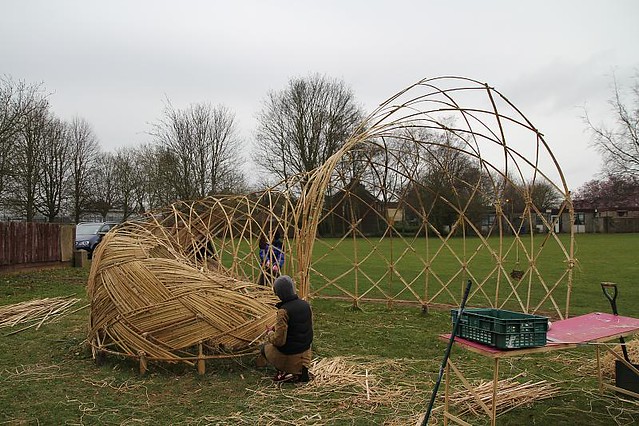
Final Major University project inspired by the dissertation research of Yona Friedman’s ideas who focuses on democratisation of design process and giving freedom in defying the spaces to the final users. Participation, he believes is very fundamental yet missing part in urban planning.
Original post by Lucie Sadakova

“A growing world population with the potential to reach nine billion by 2050 will require a 50% increase in production by 2030. To cope, the food system will need to be low carbon, resilient, environmentally restorative and sustainable in social and economic terms. It’s all exciting and challenging stuff, but this vision is only 20 short years away, has anyone thought about what effect this will have on the day to day lives of farmer? What jobs will they be doing, what new kit will there be and, most importantly, will we have a labour force with the skills to function in this climate-changed world?
At Farming Futures we know that the farming calendar doesn’t leave much time for long-term planning. So we teamed up with Forum for the Future to do some future gazing for the industry. We’ve come up with six possible new jobs or specialisms that farmers could be doing as part normal day to day farming practice by 2030.”
Original post by Rachel Wingfield

There is a great initiative by the Real Bread Campaign to show children around Britain how to Bake Your Lawn and follow the Real Bread trail from seed to sandwich on your own doorstep. Starting with just one square metre of ground and a handful of earth, their FREE grassroots guide will show you how to grow it, mill it, bake it, eat it.
Original post by Rachel Wingfield
A network of farmers, engineers, and supporters, is putting together detailed DIY guides for creating your own farm equipments and other machines.
The DIY Village Construction Set is interested in opening up the circulation of knowledge around everyday things. They are demystifying the machines and how-they-work so that all users can build and modify them according to needs and situations. Central to their open-source technology platform is the Global Village Construction Set
It features 50 different modular tools/technologies, across six thematic categories of habitat, agriculture, industry, energy, materials and transportation. Together, these tools form a functional ecology, that allows various needs to be addressed by different combination of them. The emphasis is again not only on the DIY technological solutions, but on the sustainable form of resilient village life that such technology can facilitate : DIY Village Construction Set (Stir In Some Arduino)
Original post by Rachel Wingfield

“Over the next decade, cities will continue to grow larger and more rapidly. At the same time, new technologies will unlock massive streams of data about cities and their residents. As these forces collide, they will turn every city into a unique civic laboratory, a place where technology is adapted in novel ways to meet local needs. This ten-year forecast map, The Future of Cities, Information, and Inclusion, charts the important intersections between urbanization and digitalization that will shape this global urban experiment, and the key tensions that will arise.
“The future won’t just be a flow of advanced technologies from North to South, but a complex web of nimble experiments and good ideas. These experiments will create new templates for commons creation, design and planning, markets and governance at the scale of individual citizens, networks of citizens and institutions, and entire cityscapes.”
Original post by Rachel Wingfield

Over the past year we have been working with several primary schools in the UK through the Creative Partnership scheme to develop outdoor learning environments. We are now including this branch of work with MetaboliCity and will be posting regular blogs here over the coming months.
See our photo journal for Learning Nests on Flickr here!
One of the important aspects of MetaboliCity is the notion of place-making and valuing place and there is an interesting paper about place attachment contributing to pro-environmental behaviour in education here.
Place attachment is the degree to which a place is important to people. Researchers found that place attachment contributes to pro-environmental behavior. To enhance place attachment, researchers often suggest that people need to spend more time in a place. For example educators may frequently take children out of classrooms to local ecosystems to enhance their place attachment.
I recently built a 6m in diameter and 3m high geodesic greenhouse in the center of my allotment using standard sized treated wood, a few nuts and bolts and polythene sheeting.
I am currently designing an instruction manual for the dome and will post it up once it is completed.
I have looked at possibilities for the interior but not in depth as I would not be able to afford to install something on the scale as shown below. I would like to do something with the inside which has similar functions as shown below using less resources but I’m going to need to think and research about it more before I can come to a solid and final idea.
Original post by Ilyanna Kerr

“If buildings sprang up suddenly out of the ground like mushrooms, their rooftops would be covered with a layer of soil and plants. That’s not how humans build, of course. Instead we scrape away the earth, erect the structure itself, and cap it with a rainproof, presumably forgettable, roof. It’s tempting to say that the roofscape of every city on this planet is a man-made desert, except that a desert is a living habitat. The truth is harsher. The urban roofscape is a little like hell, a lifeless place of bituminous surfaces, violent temperature contrasts, bitter winds, and an antipathy to water.”
Photograph by Diane Cook and Len Jenshel
Read full article by Verlyn Klinkenborg
Original post by Rachel Wingfield

